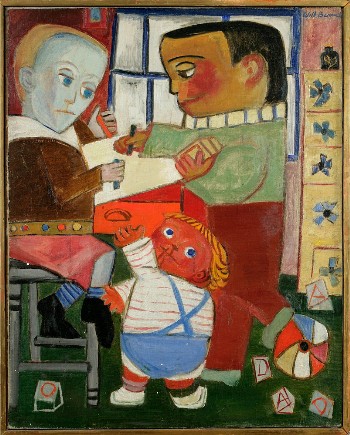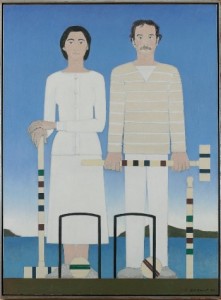Visual Arts Review: Will Barnet at 100
At the age of 100, New England artist Will Barnet accomplishes a triumph that defies all criticism.
Will Barnet at 100. At the National Academy Museum, New York, New York, through December 31.
By Franklin Einspruch
Will Barnet is still painting. The Beverly, MA native has long divided his time between New York and New England, and by “long,” I mean the last century. It’s fitting that his retrospective, Will Barnet at 100, traveled from the Portland Museum of Art to the National Academy Museum, where it runs through the end of the year.
Quite a lot of work is on offer. There are early canvases from the ’30s marked by a Van Gogh-ish earnestness and manner. These give way to prints that take cues from German Expressionism, and his work begins to look like his own. He had set up studios in the corners of a string of New York apartments as his first three children were born. Close quarters and the proximity of family led him away from the social commentary he admired in Daumier and José Clemente Orozco and toward a visual appreciation of the lives of his wife and sons.
Chief among these is a color woodblock print from 1940 depicting his son Peter sitting on a chair with a toy bird. The expression on the face of the plump-cheeked boy is either perfect absorption in his toy or the harbinger of nap time. It is a contented yet serious image, an insightful child’s portrait in cool blues, brown, and yellow.
When circumstances after World War II allowed Barnet to return to painting, he launched into a series of frankly Picassoid scenes of his children. Picasso’s colorful, wildly abstracted paintings of his daughter Maya 1938 must have been on Barnet’s mind as he worked out his own multi-figure, flat-planed, anti-perspectival, intensely colored compositions for several years leading up to 1951. Children Drawing (1946) is so unsentimental as to come off as cruel—the family toddler looks like a wild-eyed tomato placed atop a sack of flour—but it demonstrates how thoroughly Barnet mulled over the problem of Synthetic Cubism.
1951 saw him producing his first fully non-objective canvases, in which he employed a handsome but not especially distinctive style of hard-edge abstraction. Taken singly, these paintings are sometimes excellent. Whiplash from 1959 is a jaunty arrangement of angular shapes painted navy, brick red, and bone, with a striking, white coil worked into one of the fields. But in aggregate, they feel lost at sea. Barnet was able to turn Cubism into something unique to himself, but the abstractions never take on the same sense of individuality or urgency.
In the 1960s, he swerved into a peculiar take on figuration, which he explored for the next 40 years. This is the work for which he is deservedly known. Barnet hit upon a oil painting technique that appears simple: outline the forms in a thin gray line and fill in the enclosed shapes with a single color. A Japanese woodblock print works in the same way, and it’s curious that no one stumbled on it earlier. But simple paintings have few working components, and if those components go wrong, they cause disproportionate damage. Artists working thusly need unusual powers of taste.

THE BLUE ROBE, 1962, Oil on canvas 50 x 54 in., Private Collection, courtesy Alexandre Gallery, New York
Some of the early examples are superb. The Blue Robe from 1962 arranges the artist’s second wife, their daughter Ona, and a boneless cat into a beautiful abstraction of relaxed poses. Barnet’s insight was that the colors, if they’re going to be applied across the shape in this manner, need subtle variations so that they don’t appear dead flat. This modulation ends up as Barnet’s handwriting, and it gives the painting a flickering atmosphere despite its considerable precision. The gesturing of limbs, from the girl’s arms to the cat’s curvilinear body to the mother’s arm outstretched on the couch back, makes the composition snake upwards from the bottom with delicious languor.

TWO SISTERS, 1965, Oil on canvas 67 x 38 in., Collection of the Artist, courtesy Alexandre Gallery, New York
Two Sisters (1965) is almost as powerful. The sisters are the artist’s, and the portraits are duly sensitive. Cats climb on the plump one, who wears a kimono of lime edged with vermilion. The bony one with alert, blue-gray eyes holds a viridian parrot who all but disappears into the darkness of the background. Despite all of this content, the artist takes palpable delight in the play of broad shapes and crisp lines.
It diminishes these early successes not at all to note that Barnet’s mature style frequently went off the rails. His series in the 1970s of New England women waiting for their husbands to return from the sea is contrived and maudlin. Curiously, they’re more sentimental than any portrait of the artist’s children, though some of them are not even given faces. In the ’80s and ’90s Barnet flirted with folk art with uneven results. The little girl holding the toy horse in Three Chairs (1990–91) might as well be mashing it into the wall, which is clearly not what the artist intended. Sometimes it works in his favor, though, as in Croquet (1985), in which the now-grown Ona and her husband sport summer whites and croquet accouterments, standing as upright as Egyptian gods against a geometrically becalmed seascape.
Barnet has returned to abstraction in recent years, working in much the same mode as his work in the ’50s. If they still feel like they’re searching, they’re searching with a vitality that one would not associate with a man of his years. Besides, the artist accomplished a triumph that defies all criticism: the museums mounted a centenary retrospective of his work, and he attended it.



Didn’t know anything of his earlier years, but what I was hoping to see was one of his latest pieces from the work he is now producing.
Wondering about a 1970 picture called “Stairway,” oil on linen. Is it in Will Barnet’s private collection? Any ideas? I can’t find any reference to it.